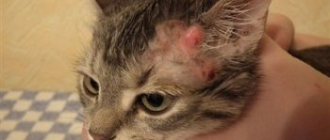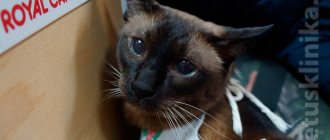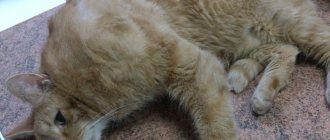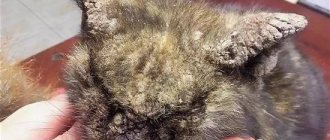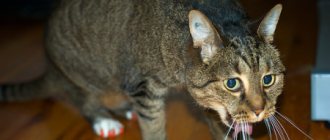A cat's lip ulcer may be caused by Jacobs disease. The disease is similar to herpes rashes on the human lip. More often, the disease affects cats that have reduced immunity.
Pedigree cats, especially the British breed, are also more often susceptible to the disease. Jacobs disease is manifested by defects in the skin, most often an ulcer on the upper or lower lip, but with extensive damage, defects in the integrity of the mucous membrane of the cheeks and abdominal skin are possible.
The structure of animal skin
The skin is the largest organ of a cat, the weight of which, depending on the species, age, and nutrition of the animal, ranges from 12 to 24% of its weight. It protects internal organs from the negative effects of the external environment, regulates body temperature, acts as an organ of touch, and performs other important functions.
The skin of a cat consists of three layers:
- epidermis;
- dermis;
- subcutaneous tissue.
Epidermis
The outer layer of the skin is the epidermis, consisting of keratinized scales. It is constantly updated. The scales leave the body when they are pushed out by young cells coming from below (the process of keratinization).
The layer is durable, elastic, capable of retaining water, salts, nutrients, and preventing infection from entering the body. There are also cells associated with whiskers and hair follicles that improve the sense of touch.
It is the epidermis that is damaged more often than others. With weak immunity, he may succumb to infection and sunlight. Fleas and ticks attack him first, gnawing holes.
basement membrane
The epidermis is separated from the next layer, the dermis, by a thin basement membrane. It is involved in cell regeneration and affects their metabolism. The elasticity of the cover depends on its integrity. Some diseases of the epidermis, as well as a number of autoimmune skin diseases of cats and dogs, can damage the membrane and disrupt its functions.
Dermis
The dermis produces collagen, which maintains skin tone. Also here is:
- A network of blood vessels through which the dermis nourishes the epidermis, fur, claws, and regulates body temperature.
- Sensory and motor nerves through which the body reacts to cold, heat, itching, pain.
- Immune cells that trap infectious agents that have been able to pass through the epidermis.
Subcutaneous layer
Subcutaneous tissue is the innermost layer. It contains subcutaneous fatty tissue, which provides insulation, is a shock absorber, and a reservoir for liquids, electrolytes, and glucose.
Wool
One of the appendages of the skin is wool. Hair follicles in adult pets are complex - they have a central hair surrounded by small hairs that come from one common pore.
Their growth and condition are affected by nutrition, hormones, molting, and health. The sebaceous glands secrete a secretion that moisturizes the skin and makes the coat soft and shiny. The color of the coat can vary depending on the time of year, temperature changes, and the amount of sunlight.
Wool protects the animal's skin from physical damage and ultraviolet radiation. It helps regulate body temperature, so it's longer in winter. In summer, the coat is not only shorter, but also has fewer secondary hairs, allowing air to pass through it calmly, cooling the skin.
Cat claws
Another appendage is the claws. The cat uses them as a tool for protection, catching prey, holding meat, and climbing. By contracting the tendons, it can retract or extend them back and forth.
How to cure a pet?
Of course, treatment does not need to begin until a final diagnosis is made. Each of the described conditions requires an individual treatment regimen. The drug Dexamethasone is often used to treat conditions that cause swollen lips and lesions in the mouth. Dexamethasone has the active ingredient dexamethasone disodium and is available in the form of injection ampoules. Dexamethasone has anti-inflammatory, anti-allergic and anti-shock effects.
In case of infectious lesions, Dexamethasone complements antibiotics. Dexamethasone should be given in the dosages specified in the instructions for use. Another drug that has a detrimental effect on a number of pathogenic microorganisms is Sinulox. Sinulox is available in the form of a suspension or tablets. Sinulox is effective for infectious lesions of soft tissues and mucous membranes. Sinulox is often prescribed for gingivitis. Sinulox should be given strictly according to the instructions for use. There is a tablet form of Sinulox.
Causes of skin diseases in cats
Poor care, poor diet, stress, medications, plastic bowls - in veterinary medicine, animal skin diseases can be caused by various reasons. When a pet is sick or frequently encounters an irritant (eg, an allergen), its immunity weakens. She becomes vulnerable to opportunistic organisms that always live in her body (for example, dermatitis mites) and do not normally appear.
Other causes of skin diseases in cats:
- allergies to food, inhaled compounds, flea bites and other substances with which the pet comes into contact;
- communication with sick animals;
- fungal infections;
- bacterial disease of the hair follicles;
- trauma, skin damage, causing inflammation or abscess;
- adverse reactions to medications;
- fleas, ticks;
- hormonal imbalances.
Skin diseases of cats: general symptoms
There are a number of symptoms of skin diseases that will indicate a problem, regardless of the cause:
- severe itching;
- hair loss, bald patches;
- redness;
- dryness, peeling, scabs;
- dull coat color.
The animal constantly itches, scratches, and chews its skin to reduce the pain of symptoms of skin diseases in cats. She may also lick the fur too much to soothe the irritated coat.
Caries
The process of demineralization, accompanied by the destruction of the hard shell of the tooth and the formation of a cavity in its tissues, is called caries.
Caries occurs in several forms, which characterize the depth of damage to hard tissues:
- stage of a light spot (reverse development of the pathological process is possible for unknown reasons) - there are no changes in the structure of the tooth;
- superficial carious process - a dark pigment spot appears on the enamel, the enamel softens;
- with average carious lesions, enamel and dentin suffer;
- deep damage leads to complete damage to the tooth, affecting all its tissues, and attacks of acute pain are possible if hot or cold food comes into contact with the tooth; after the cessation of exposure to the temperature factor, the pain stops.
In the acute course of the pathological process, several teeth may be affected. In this case, the affected areas look like dirty gray spots.
Symptoms:
- decreased pet appetite;
- changes in the cat’s eating behavior (the animal may chew on one side or try to swallow food with minimal chewing movements);
- foul odor from the mouth;
- hypersalivation;
- change in color of the affected tooth;
- pain when chewing.
The cat cannot complain of pain, but will avoid any touching of the sore tooth.
Treatment:
1. At the initial stage, the veterinarian can use local antiseptics:
- silver nitrate;
- sodium fluoride.
2. If the damage is serious, the tooth is removed.
============================================================================================================================================================================================
Types of skin diseases in cats
The classification of skin diseases in cats is based on the cause of the disease. Mainly found:
- allergic dermatitis;
- fungal infection;
- bacterial infection;
- parasitic infection;
- psychogenic factor.
Dermatitis
Cutaneous dermatitis in cats is a group of diseases associated with inflammatory disease of the skin. Their cause is allergies, age, genetics, trauma. The group includes:
- allergic dermatitis;
- eczema;
- toxicerma - exposure to toxic substances circulating in the blood (medicines, chemicals);
- atopic dermatitis - hereditary skin diseases in cats;
- hives.
Dermatitis in cats has characteristic symptoms. Kittens develop purulent blisters on the face, stomach, and groin. In adult pets, spots appear in the area of the knee joints, along the back. Papules and acne are visible.
How to treat dermatitis in a cat
Saphroderm gel is prescribed for the treatment of dermatitis in cats. The medicine quickly relieves inflammation, heals wounds, and has an antiseptic effect. It helps against eczema, trophic ulcers and other skin inflammations of a non-infectious nature.
Also, for the treatment of dermatitis in cats, the following medications are prescribed:
- Imunofan (NPP Bionox) in ampoules. The hormonal drug restores impaired immune function and acid-base balance.
- Stop-Itching for cats (Api-san), bottle. 10 ml. The suspension relieves itching, inflammation, improves blood circulation in tissues. The drug contains B vitamins, which promote cell restoration.
- Hepatovet Active (Api-San) for cats, bottle. 25 ml. The drug improves the functioning of the liver, which is responsible for processing poisons, incl. – neutralization of allergens.
Allergic dermatitis
Allergies develop when a pet's immune system reacts too strongly to foreign substances that have entered the body. The reaction often occurs to fleas, a certain food item, airborne particles, or objects that the animal comes into contact with (a bowl).
The main allergic signs of skin diseases in cats:
- itching, due to which the animal constantly itches, rubs, shakes its head, gnaws its paws, in the tail area;
- red rash, bumps;
- hair loss, baldness;
- runny nose, drooling;
- fever;
- vomiting, diarrhea, gas, or bloating;
- sneezing, coughing, wheezing.
- swelling, anaphylactic shock, death (in severe cases).
What to do?
For cat skin disease, treatment often involves a hormonal injection to relieve the itching. But this is only a temporary measure. When the medicine wears off, the disease will return.
Therefore, if signs of allergic dermatitis are detected in cats, it is necessary to calculate or eliminate the allergen - change the diet, treat for fleas, buy a bowl or bedding made of high-quality material. If the source cannot be detected, the pet’s blood must be tested to determine the irritant.
The following will help relieve allergies at home:
- Immunofan – improves immunity;
- Stop-Itching suspension – relieves scabies
- Hepatovet – strengthens the liver, which helps it process toxins.
Fungal infections
Fungi are microorganisms that reproduce by spores by eating host cells. Over time, they penetrate into the deep layers of the skin, become fixed, after which it is not easy to destroy them. In advanced cases, they can even enter the bloodstream and poison the body.
There are many fungi in the world, but only a few cause disease. The main cause of infection is direct contact of the skin (fur) with the fungus. Some organisms constantly live on the skin, without showing themselves in any way, and are activated when the body weakens.
The following types of fungal skin diseases in cats can be distinguished:
- Aspergillosis - affects the respiratory system, nose. The infection develops against a background of stress and weakened immunity. May manifest as swelling of the muzzle, pneumonia.
- Candidiasis - affects the skin and mucous membranes of the mouth, nose, and eyes.
- Cryptococcosis – damages the respiratory tract (especially the nasal cavity), brain, eyes, face and neck. Cats often become infected by pigeons by inhaling bird droppings. Symptoms include bloody, purulent nasal discharge, soft or hard nodules on the skin that can develop into ulcers, depression, seizures, paralysis, and blindness. Lack of treatment can cause death.
- Mycetomas are a fungal disease of the subcutaneous tissue, as a result of which small nodules appear on the face and paws.
A dangerous disease is ringworm. This is a highly contagious disease caused by the fungus dermatophyte. It appears on the face, ears, tail, and feet in the form of bald patches covered with crusty scales. The fur around them is dull, with broken hairs. Sometimes small, hard bumps appear, causing itching. They can develop into large bumps with ulcers.
Fungal skin diseases of cats and their treatment
Before treating the disease, it is necessary to determine the type of fungus. A medicine designed to eliminate one parasite does not always cope with another. To do this, the veterinarian takes a sample of the damaged tissue for examination. If the analysis fails, you can use a universal medicine developed for different types of fungi.
The following drugs will help eliminate the disease and prevent its occurrence:
- Vakderm is a vaccine that will protect against ringworm and some other types of fungi.
- Gamavit is a drug that strengthens the immune system, helping the body fight fungal infections.
- Fungin forte spray is effective for ringworm, as well as for diseases caused by Trichophyton, Microsporum, Epidermophyton, Achorion.
- Yam BK ointment is used to treat various types of fungi and eczema. It has antiseptic, keratolytic, astringent properties.
Parasitic skin diseases in cats: how to treat them
The most common parasitic disease is fleas, which live on the skin and hide behind the animal's fur. The main symptom is that the pet itches and chews itself. As infection progresses, the itching intensifies.
It used to be difficult to get rid of fleas. Now the problem is solved with the help of drops, sprays, tablets, and special collars. For skin diseases in cats, the following drugs are prescribed:
- Bass Forte;
- Celandine Spray;
- Blokhnet;
- Delcid;
- Celandine C325, shampoo.
Scabies is a parasitic skin disease. Its cause is mites, so small that they cannot be seen without a microscope. Females dig holes in the animal's skin, causing itching. Another symptom of the disease is baldness in the affected area.
Just a few years ago, scabies and demodicosis were considered an incurable disease. Now the course of skin disease in animals can be controlled with the help of tablets, drop injections, sprays - Advocate, Ivermek, etc. “Stop-Itch Suspension” will help relieve scabies.
Seborrhea
Seborrhea in a cat is a condition when dandruff (dry form) appears on the animal’s fur, the fur is glued at the base, and there are plaques on the skin (oily). It develops due to increased activity of the sebaceous glands, caused by hormonal imbalance, mites or poor nutrition.
What to do?
To rid your pet of seborrhea, normalize his diet, take a hormone test, and adhere to the prescribed treatment. The following products will help improve skin condition and eliminate diseases:
- Essential 6 spot-on (LDCA). Contains essential oils that irritate, soothe and moisturize sore skin. The method of use is simple - apply the product to the skin near the shoulder blades, after which it will distribute itself throughout the epidermis.
- 8in1 Excel Brewers Yeast with brewer's yeast and garlic. The complex supplement contains useful substances, B vitamins, Omega-3, which have a good effect on the skin and coat.
Diagnostics
The absence of anxiety in an animal when an ulcer appears on the upper lip is the main symptom of the disease. A biopsy will help confirm the assumption. The veterinarian takes a microscopic piece of skin from the affected and healthy areas. If the analysis shows eosinophilic proliferation, then this is a reason to diagnose Jacobs disease.
Attention! In a blood test, the number of eosinophils may be normal, therefore, in case of non-healing red spots on a cat’s lip, only a biopsy is considered reliable.
If the animal has a history of viral leukemia or the cat has recently been ill, then a veterinarian who discovers a spot on his patient’s lip should immediately check the diagnosis.
Preventive measures for skin disease in cats
- Get the vaccine against fungal diseases (Vakderm) on time.
- Don't let your cat go outside. A pet that walks without control may well come into contact with sick animals.
- Support your pet's immunity. For prevention, give medications to strengthen the liver (Hepatovet) and immunity (Immunofan).
- Give the animal only high-quality food, do not overfeed.
- Consult a doctor at the first symptoms of cat skin diseases and begin treatment immediately.
Tartar
In fact, tartar is the same plaque, which is a colony of microorganisms that has only undergone calcification. It is quite strong and hard, has a brownish tint and is capable of growing.
Symptoms:
- Finding dark yellow or brown growths on your cat's teeth.
- The appearance of bad breath.
- Bleeding and inflammation of the gums.
- Soreness may appear, the cat may begin to eat poorly, or even lose its appetite.
Treatment:
1. Grinding of teeth with a special paste. Used at the initial stage of the disease.
2. Tartar removal: mechanical or ultrasonic.
============================================================================================================================================================================================
Stomach ulcers
There are two types of stomach ulcers.
- Simple gastric ulcers in cats with an irregular shape and relatively good healing
- Peptic ulcers with a round shape and thick edges.
Causes
This disease occurs quite often in cats, since there are many reasons for its occurrence.
- Various wounds, injuries and other damage to the gastric mucosa, for example, a purr may accidentally swallow a small bone or nail.
- Stress.
- Poisoning.
- Long-term feeding with cheap dry food, such as Whiskas.
- Chronic pancreatitis.
Symptoms
It is difficult not to recognize a stomach ulcer, since any cat owner will see its signs.
- Weight loss.
- Loss of appetite.
- Vomit.
- Depressed state of the animal.
Treatment methods for stomach ulcers in cats
Having diagnosed a stomach ulcer in your furry pet, the veterinarian will prescribe sedatives, painkillers and antispasmodics, as well as drugs that protect the walls of the stomach and help speed up scarring.
But treatment of this disease cannot guarantee any effect without the use of diet therapy. A recovering purr should be fed lukewarm and semi-liquid food - purees, soups and soufflés, 3-5 times a day. The veterinarian will most likely recommend one of the ready-made diets - Royal Canin, Ekanuba or Hills.
Indolent ulcer
Indolent, otherwise called eosinophilic, ulcers in cats are localized in most cases above the upper lip.
The early stages are manifested by small ulcers with a concave surface. As the above disease progresses, the size of the lesions increases and acquires a reddish-brown tint. In the future, such ulcers will be characterized by slightly raised edges, as well as ulcerated masses.
How to properly treat an indolent ulcer? Aibolit prescribes a course of glucocosteroids for the cat (this can be cyclosporine, prednisolone or similar drugs), as well as antibiotics (amoxicillin and clavulanic acid are most often prescribed).
